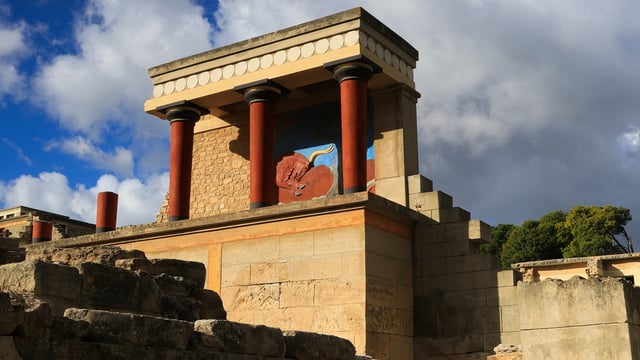Crete
Art, History & Archaeology Sites & Museums
This page, part of our Greece Travel Guide, provides details of the art, archaeology and history sites, museums and related attractions to visit on the island of Crete. Readers wishing to visit these places will find visitor information, links to official websites as well as other helpful resources. The guide is produced by Thomas Dowson, an archaeologist and the founder of Archaeology Travel, who has been visiting Greece regularly since 1990, , and is currently researching a comprehensive guidebook to Athens. Read more about the website, its authors and our work.
New to the Archaeology Travel website? Those who have an account (free of charge) can create personal travel lists and itineraries. To benefit fully from the various travel planning features, see the User’s Guide.
Archaeology & History Sites in Crete
Aptera Archaeological Site
The archaeological site of Aptera has a spectacular Greek theatre with wonderful views, and a number of Roman ruins as well as the remains of a monastery. First mentioned in the late 12th century, the Monastery of St. John the Theologian was active until 1962. Overlooking the Bay of Souda meant the ancient town of Aptera was an important city from at least the 8th century BC. It prospered during the Roman period, but suffered a devastating earthquake in the 7th century AD, and subsequent raids by the Saracens.

Aptera Ottoman Fortress
The unmissable Ottoman fortress near the archaeological ruins of Aptera is one of the best preserved 19th century fortresses in Crete. Building started in 1867 following the 1866 Cretan Revolution under orders of Huseyin Avni Pasha. The strategic location, overlooking the port of Souda, was specifically chosen to to maintain control of the valley of Apokoronas below. After the end of the Turkish occupation of the building was used as a school for the nearby Apoptera Village. Although it looks very well preserved, it is not considered safe to enter. But visitors to the fortress are rewarded with wonderful views.

Fortezza Rethymno
Visible from most points around the city of Rethymno is the Venetian stronghold of Fortezza. It was built between 1540 and 1570 when the island was under Venetian rule to protect the commercial port against Ottoman attack. In 1646 Fortezza fell to the Ottomans. Besides the outer fortifications, a number of internal features have survived. These include the Ibraham Han Mosque and the late 19th century church of Agios Theodoros Trichinas. From the fort visitors get panoramic views of Rethymno and beyond.

Gortyn
Although a flourishing city was mentioned by Homer, it was not until the Hellenistic era that the city of Gortyn was at its most prosperous and powerful. During the Roman period the city became the capital city of the province of Creta et Cyrenaica. Later, in the 6th century AD a Christian cathedral was erected and dedicated to St Titus, the ruins can still be seen today. The site is best known for the Gortyn Code, discovered in 1884 it is the most complete and oldest example of a code of ancient Greek law.

Knossos
Knossos is an important archaeological site that figures prominently in the history and development of archaeology. Excavations began in 1900 by Sir Arthur Evans and carried on for 35 years. Although many of his reconstructions and interpretations are now questioned, it is thought that the ruins are those of a political and ceremonial centre that was at the heart of Bronze Age communities on Crete. There is also archaeological evidence at the site for Neolithic and later Classical occupations.

Phaistos Archaeological Site
Phaistos was an important centre of Minoan civilisation on the island of Crete, the wealthiest and most powerful in southern Crete. At the centre of the substantial Minoan city was, according to many archaeologists, the finest of all the Minoan palaces. The earliest evidence of habitation dates to the Neolithic, while the first palace was constructed during the 15th century BC. Of a much more recent age are the archaeological remains of the Venetian church of St. George of Phalandra.

Spinalonga
Although the island of Spinalonga has a fascinating Venetian and Ottoman history, it is better known today as a result of being the setting of Victoria Hislop’s 2005 novel The Island, and adapted for TV. An island on which those who suffered leprosy were quarantined from 1903 to 1957. Now the island is a popular day trip for tourists to Crete. Besides the ruined features of the hospital, visitors can also explore the Venetian fortress – one of the most important in the Mediterranean due to its strategic location.

Museums & Art Galleries in Crete
Archaeological Museum of Heraklion
The archaeological museum in Heraklion is one of the largest and most important archaeology museums in Greece. Not only does the museum have extensive displays of some 7,000 years of Cretan prehistory, from the Neolithic to the Late Roman period, it also has the finest collection of Minoan art and artefacts. Some of the island’s most iconic objects can be seen in permanent exhibitions, these include the enigmatic Phaistos disk, the bull head rhyton from Zakros and bull leaping fresco from Knossos.











